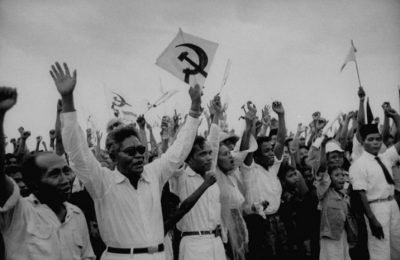The Jakarta Method: Mass Murder in the Service of Washington
A review of The Jakarta Method: Washington’s Anticommunist Crusade and the Mass Murder Program that Shaped Our World by Vincent Bevins

All Global Research articles can be read in 51 languages by activating the “Translate Website” drop down menu on the top banner of our home page (Desktop version).
Visit and follow us on Instagram at @crg_globalresearch.
***
At its height in the early 1960s, the Communist Party of Indonesia (PKI) had 3 million members. It was the third largest in the world, behind only the communist parties in the Soviet Union and China.
Around a quarter of the entire population of Indonesia belonged to organisations affiliated to the PKI. It was doing increasingly well in elections, so much so that then US Vice-President Richard Nixon is quoted as saying “a democratic government was [probably] not the best kind for Indonesia” since “the Communists could probably not be beaten in election campaigns because they were so well organized”.
Since 1945, the president of Indonesia had been Sukarno, whom author Vincent Bevins describes as “a left-leaning Third World nationalist”, committed to being on good terms with both the USA and the Soviet Union. Sukarno’s 1955 conference in Bandung, Indonesia, “brought the peoples of the colonized world into a movement, one that was opposed to European imperialism and independent from the power of the US and the Soviet Union”.
Although a nationalist rather than a communist, Sukarno was sufficiently anti-colonialist and sufficiently tolerant of the PKI that Washington was very worried (as it is still) by the threat of a good example. Bevins tells how a meeting of a secret committee of the US National Security Council reached the conclusion that “the loss of a nation of 105 million to the ‘Communist Camp’ would make a victory in Vietnam of little meaning”.
It is easy to imagine how a country as populous as Indonesia, with a massive communist party and governed by a president committed to anti-colonialism and anti-imperialism, would be anathema to the US and its allies.
Bevins admits that 50 years later, we still lack a complete understanding of the events of the night of September 30th 1965, when a group of army officers apparently attempted to foil a right-wing plot against Sukarno by kidnapping seven of the highest-ranking generals in the Armed Forces.
By the next morning, six of the generals were dead, but the outcome was a catastrophe: “within 12 hours, the September 30 movement was crushed, and the army now led by right-wing General Suharto, was in direct control of the country”.
Suharto proceeded to literally demonize the PKI. Allegedly aided by covert, ‘black propaganda’ ops run by the US and British, Suharto “managed to give official legitimacy to a wildly anti-communist narrative, an absurdly fanatical and exaggerated version of global right-wing ideology”.
The eventual outcome was horrific. Bevins estimates that between 500,000 to 1 million completely innocent Indonesians were murdered.
This is the “Jakarta Method” of the book’s title: state-organised extermination of anyone deemed to have the slightest sympathy or connection with the left.
The success of the Jakarta Method was not confined to Indonesia, although the scale was smaller elsewhere. Bevins explains that “in the years 1945 – 1990, a lose network of US-backed anti-communist extermination programs emerged around the world, and they carried out mass murder in at least 22 countries”.
Bevins lists Argentina, Bolivia, Brazil, Chile, Columbia, East Timor, El Salvador, Guatemala, Honduras, Iraq, Mexico, Nicaragua, Paraguay, the Philippines, South Korea, Sudan, Taiwan, Thailand, Uruguay, Venezuela, and Vietnam. He suggests that the murders committed in these countries (not including direct military engagements or civilian “collateral damage” in wartime) contributed to the eventual outcome of the Cold War.
One of the best and most moving features of the book is that Bevins interweaves the wide-angled geopolitical story with the stories of a number of ordinary Indonesians caught up in the maelstrom. These are voices we hear very seldom in the West.
Now old, “they are living out their last years in a messy, poor crony capitalist country, and they are told almost every single day it was a crime to want something different”.
Bevins’s powerful book is essential reading for anyone trying to understand how we got from the optimism of the 1960s to the world of Bolsonaro, Trump and Johnson, though it’s worth remembering that at the time of the mass murders in Indonesia, the US had a Democrat as president and the UK a Labour prime minister.
While it is a shame that the first edition of such a meticulously researched and footnoted book came without an index, thankfully subsequent editions have included one.
*
Note to readers: Please click the share buttons above or below. Follow us on Instagram, @crg_globalresearch. Forward this article to your email lists. Crosspost on your blog site, internet forums. etc.
Featured image: PKI supporters rallying during the 1955 general election campaign. Photo: Wikimedia Commons

